In case there was any doubt, this Puzzler is about mag checks. Specifically, it’s to introduce a new way to display the data from mag checks. For a while now, analysts have been doing this manually and now we have a button that automates the process. And we decided to make it available to all users of Savvy Analysis. Let’s start at the beginning.
Our default display puts EGTs on top and CHTs on bottom. Our GAMI button (the gold G in the column of icons under Sigmund) transforms the display into EGT-only and overlays fuel flow. That button has been there since day one of Savvy Analysis. Now, underneath the G there’s an M which will display EGTs on both top and bottom, then isolate the odd cylinders on top and the even cylinders on bottom. From here out I’ll call it the Mag layout.
The goal of a LOP mag check is to identify weakness in the ignition system. A weak plug or harness might go unnoticed with a rich mixture on both mags. Going lean and down to one mag gives the weak plug nowhere to hide, and will usually result in a misfire. The instructions in our test profile are to lean as far as you can without experiencing significant engine roughness. We know that if you start too lean, you will probably identify the weak plug, but you can incite even the good plugs to misfire. With that background, let’s look at some data.
Here’s a mag check from an SR22T with a Continental TSIO-550-K, using the default display.
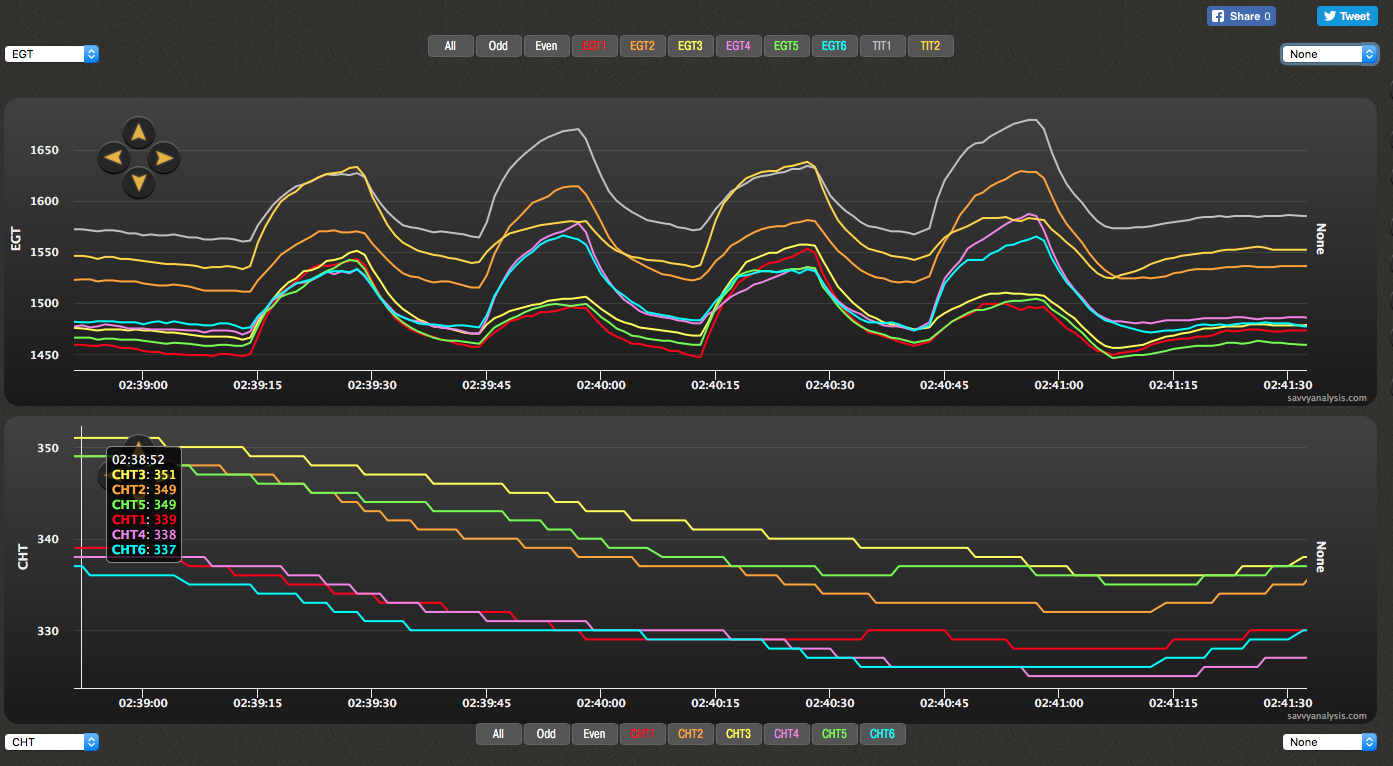
Here’s the same data as displayed in the Mag layout using the gold M button in the right column.
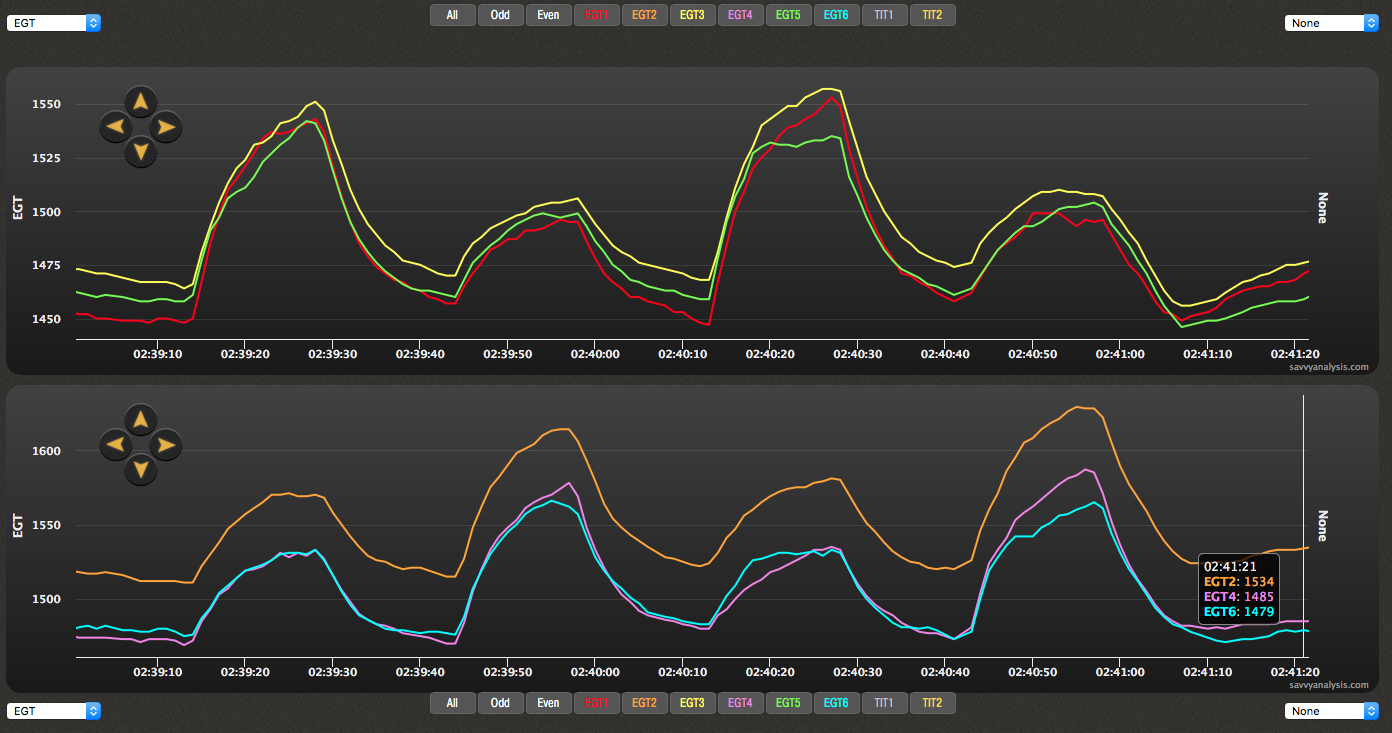
We’re looking for a 70-100º rise from the BOTH setting to single-mag ops, and a reasonably consistent rise from one mag to the other. We expect the bottom plugs to show a higher EGT than the tops because of the difference in their proximity to the exhaust valve. The test profile suggests BOTH-L-BOTH-R-BOTH but we don’t always see that – sometimes the even plugs are higher first. We can still use the data, as long as we can spot which are the tops and which are the bottoms. On this one it’s easy. L mag firing the bottom plugs of the odds is first, followed by R mag firing the top plugs of the odds. On this one we also got two checks for the price of one. The test profile doesn’t ask for two tests of each mag, but if you have the time, it’s nice to have the extra data.
This new layout makes it easy to see the nice rise from bottoms to tops. At this point we’re not concerned that EGT 2 is higher overall. Looking back to the first graphic showing EGTs and CHTs, CHT 2 is not higher overall, so it doesn’t appear to be running lean due to a clogged injector or an induction leak.
If you’re in the Mag layout, you can’t activate the Delta tool to calculate the raw numbers, but you can reload the page, click a Start and End point, and the numbers will display in the added window on the right. Since we’re displaying the change from one mag to the other, you’ll see 3 positive numbers and 3 negative numbers, and in this case the changes are remarkably consistent.
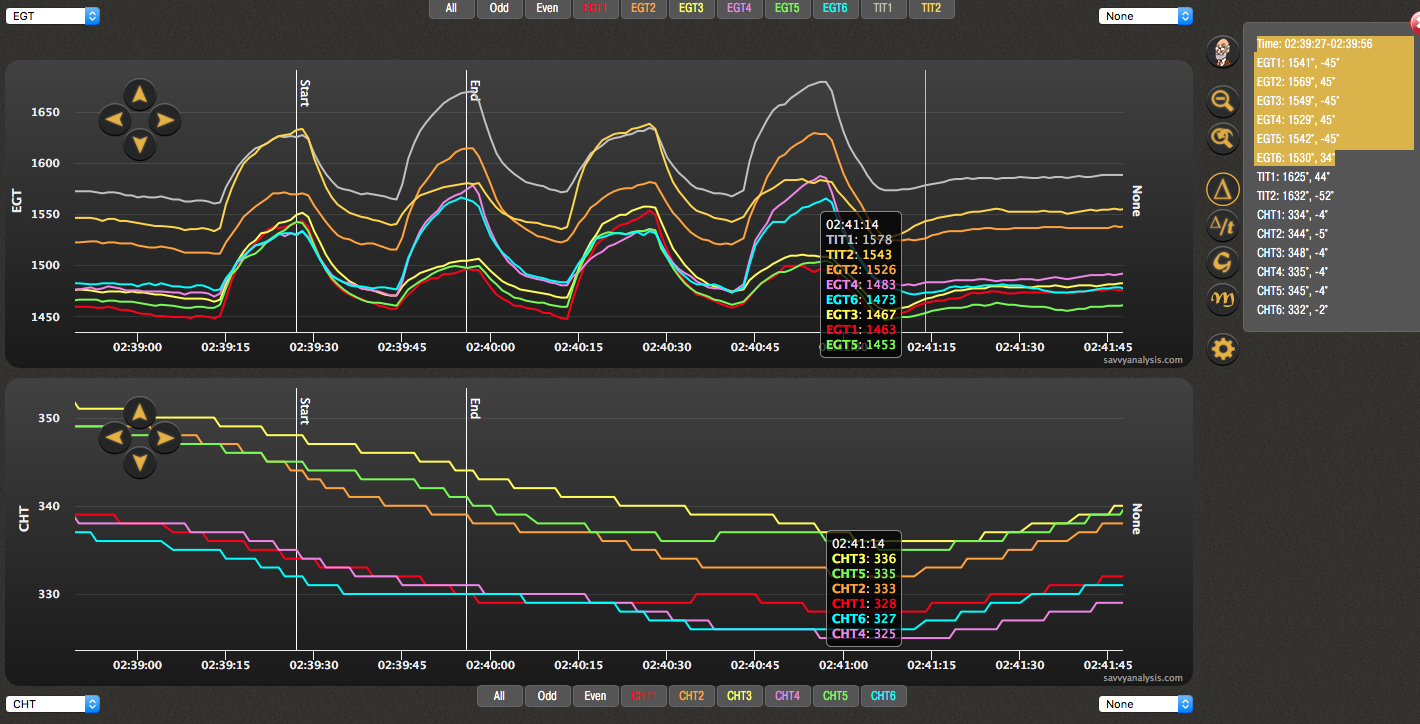
Now that we’ve solved the puzzle about the new button and what it does, let’s apply it to some data. Here’s data from an SR22 with a normally aspirated Continental IO-550-N using a Garmin G1000 with a 1 sec sample rate. Do the mags need to be timed?
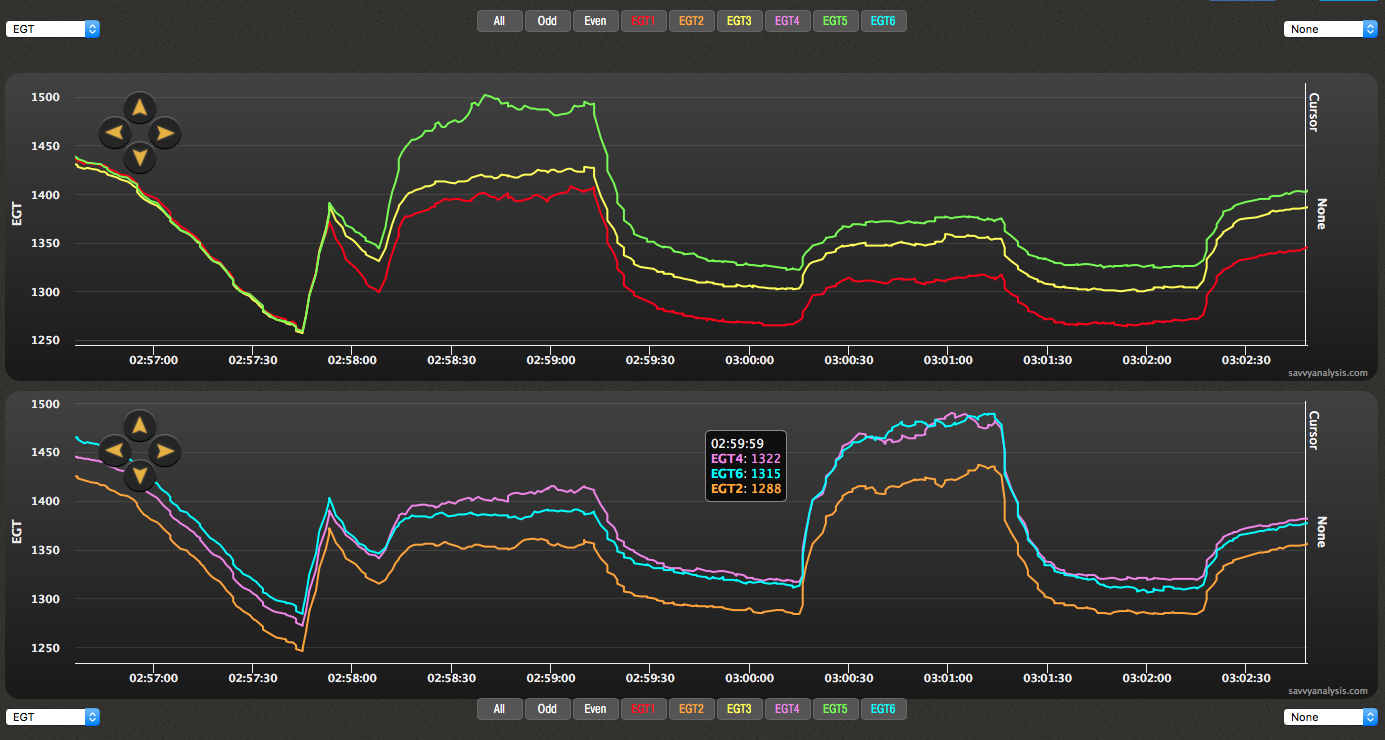
5 of the 6 plugs act as expected. The bottom plug of cyl 5 – the green trace of the first mag checked – is a little wobbly. All bottom plugs of 2, 4 and 6 are a little less steady than the others – not quite as bad as bottom 5. But while the individual traces are wobbly, the odd and even patterns indicate that mags are closely timed.
As far as recommendations, this data is borderline. If the client reported roughness during single-mag ops, the data tells us where to look, and we’d recommend examining and gapping plugs 2, 4, 5 and 6. If it was smooth, and the wobbly data is the only indication of trouble, and that’s often the case, we’d continute to monitor and suggest deferring maintenance until a subsequent check reveals a trend in the wrong direction. Unless, or course, we get additional data like “By the way, I’ll be crossing the Atlantic next week.” We don’t want to recommend unnecessary maintenance on a plug just because it misfired at an extremely lean mixture, but context matters and a small item takes on greater significance if you spend a lot of time over water or in hard IFR.
For a mag check, we like to have 10 contiguous samples for each mag, and about that much recovery time between them. So for the Avidynes that’s a minute, for JPIs at 2 secs that’s 20 secs, and for the newer monitors with a 1 second rate, 10 seconds should be enough.
However, being pilots, we know it’s asking a lot to let a rough running engine shake itself on the mounts without intervention for 60 seconds. Even 10 seconds is a long time. You’re the PIC, so do what’s safe and if you switch to one mag and 2 of your 6 plugs are spitting and coughing, don’t suffer. Submit what you have and hopefully that’s enough to suggest a remedy.
Sometimes we are asked “What’s the recommended fuel flow for the LOP mag check?” Obviously it changes from engine type to engine type, but after almost five years of data, we have noticed enough of a pattern for a ballpark starting point. Let’s say you begin your mixture (GAMI) sweeps at 100º ROP and that’s about 14 GPH. You slowly lean to the onset of roughness (remember you’re on both mags for this part) and that happens at about 9.5 GPH. You reverse and richen again back to about 14 and repeat that for the series of 3 sweeps. Now it’s time for the mag check.
If you got roughness at 9.5 on BOTH mags, we can presume 9.5 is too lean to support smooth combustion on one mag. So a rule of thumb is to start about 50º LOP. That should equate to a FF number that’s about 25-30% richer than the lowest FF on your sweeps. So for 9.5 that would be in the high 11s. Maybe start at 12 and if it’s smooth, lean a little. Once again, the goal is to identify weak spark, not to cause it.
Quick sidebar on the subject of mixture sweeps. Shortly we’ll look at the mag checks from this Experimental with a Lycoming IO-320 using a Dynon Skyview with a 1 sec sample rate. For now let’s look at the sweeps.
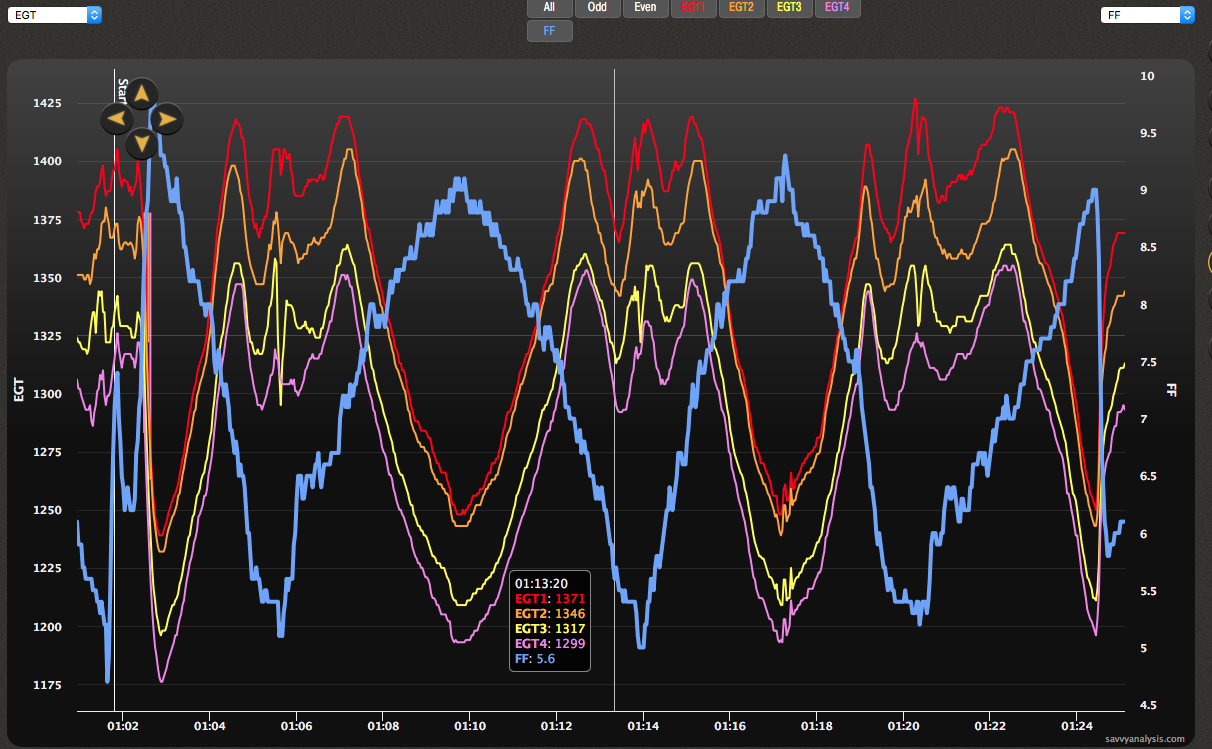
The mixture rate of change isn’t perfectly linear but good enough to define a good peak. Then, as the leaning continues, we get another rise and peak. Had leaning continued, we should have seen one or more EGTs drop dramatically, as they ran out of fuel to burn. For purposes of analysis, we had what we needed by 5.6 GPH (where the cursor is), and the fact that roughness didn’t set in there verifies the excellent distribution of this engine. Eyeballing it, EGT 2 – the brown trace – looks a little leaner than the others, and is the one we’d suspect to be first to flame out if FF got low enough. But EGT 3 – the yellow trace – shows the most dramatic drop in the middle of the 3 peaks.
Back to the Mag layout. When analysts look at mag checks for the Savvy Analysis report, we overlay FF to be sure it didn’t change from one mag to the other. If FF changes, we can’t draw meaningful conclusions about timing. We considered overlaying FF in the Mag configuration, but decided to keep it clean and simple. That’s why you don’t see TITs displayed for the turbos.
When analysts write a report, we start with the mixture spreads, then look at mag checks, then move to FF, RPM and MAP (for turbos). For those parameters we want the default display zoomed in to the takeoff in the timeline, then we overlay each of those items. But sometimes we look at a mag check out of the context of a report. Since there wasn’t consensus on what should display when the Mag layout closed, use the Mag layout button for mags, then use your browser’s page reload command to get back to the default display.
Let’s finish with a mag check from the Experimental whose sweeps we saw earlier. Only four EGT traces this time. Do the mags need to be timed? Hint – are we sure that they’re mags?
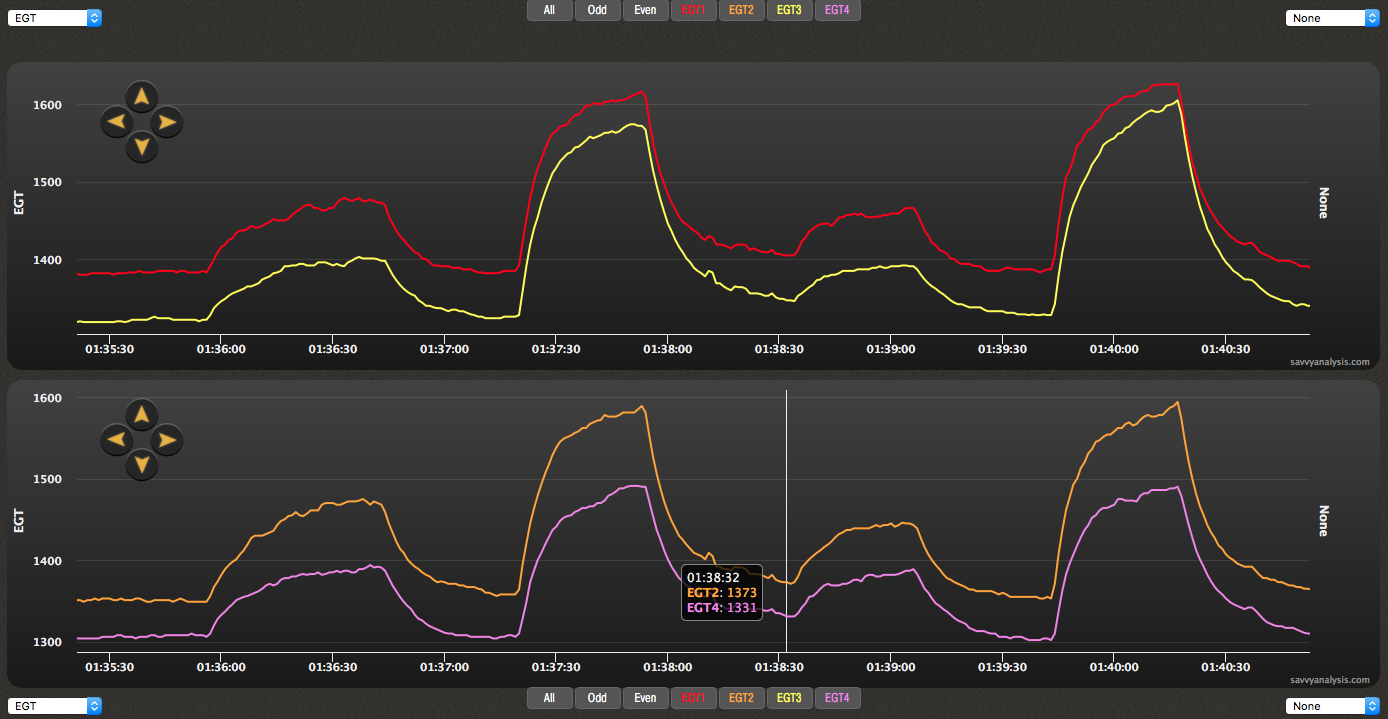
Most engines that we analyze use two mags, one firing the tops of the odds and the bottoms of the evens, and the other firing the tops of the evens and the bottoms of the odds. Some engines use one mag for all the tops and the other fires all the bottoms. That’s the case here, plus the added wrinkle that the tops are fired by a traditional Slick mag, while the bottoms are fired by an electronic ignition that varies with power settings, up to 34º BTDC. So we can report no evidence of misfires, but what can we say about timing?
That brings us to a change we recently made in our reporting phraseology. Up to now we’ve said either “mags appear to be closely timed” or “mag timing appears to be split.” In this case, and in the case of RAM engines where one mag is intentionally advanced 2º over the other, our comment is “mags appear to be timed appropriately.”
That’s the new Mag layout. A while back we added the ability to share flight data with Twitter and Facebook. This is the first big change to the Savvy Analysis user interface in a while, but we’re always working behind the scenes to keep pace with changes made by engine data monitor manufacturers.